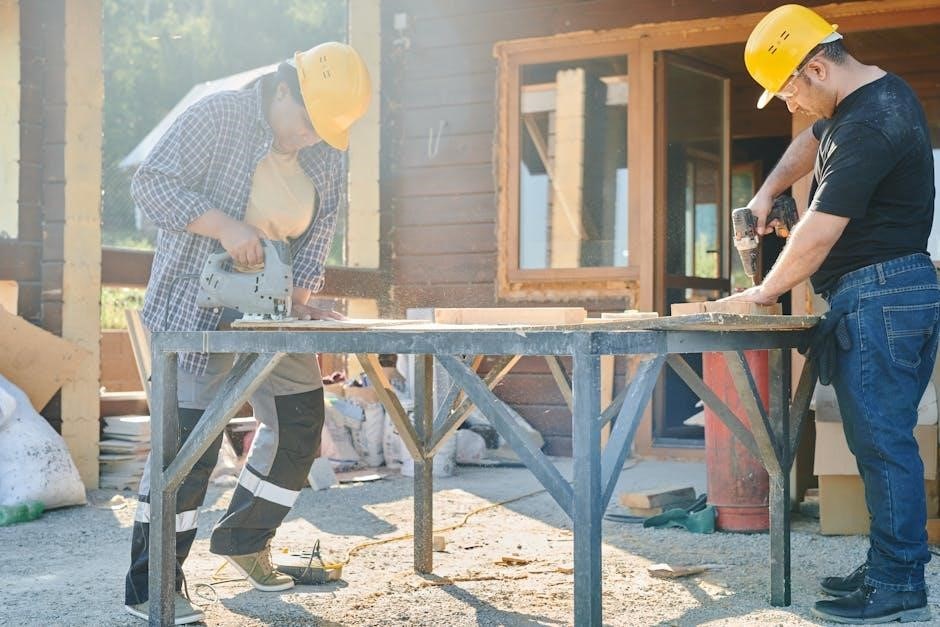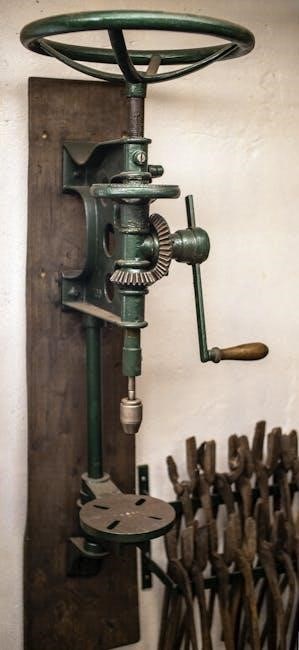manual drilling
Manual drilling is a reliable method utilizing human energy to construct boreholes for sustainable water access, emphasizing cost-effectiveness, simplicity, and environmental friendliness worldwide.
Definition and Purpose
Manual drilling involves using human energy and simple tools to create boreholes for water access. Its primary purpose is to provide affordable, sustainable water solutions, particularly in rural or remote areas with limited machinery access, ensuring clean water availability for drinking, irrigation, and domestic use.
Historical Context
Manual drilling has ancient roots, with early civilizations employing basic tools to access groundwater. Its evolution over centuries highlights its adaptability, becoming a vital method for water supply in remote areas. Historically, it has been crucial for communities worldwide, particularly in regions with limited technological resources, ensuring sustainable water access for generations.

Manual Drilling Techniques
Manual drilling techniques include percussion, hand auger, and jetting methods, offering cost-effective, low-tech solutions for water access. These methods are globally applied in various geological conditions.
Percussion Drilling
Percussion drilling is a manual method using a hammer and chisel to break through rock layers. It is slow but effective for consolidated formations, making it ideal for remote areas with limited resources.
Hand Auger Drilling
Hand auger drilling uses a spiral blade to extract soil and create boreholes, ideal for shallow groundwater in soft formations. It is cost-effective, portable, and widely used in rural areas, especially in countries like Bangladesh and India, where it provides accessible water solutions with minimal equipment.
Jetting Drilling
Jetting drilling uses a high-pressure water jet to flush out soil and debris, ideal for loose and soft formations. It is faster than other manual methods, suitable for shallow depths, and commonly applied in regions like Bangladesh and India for water access, offering an efficient and adaptable solution for groundwater extraction.
Advantages of Manual Drilling
Manual drilling offers simplicity, efficiency, and cost-effectiveness, making it a sustainable method for water access in remote and urban areas. It empowers communities globally, improving livelihoods.
Cost-Effectiveness
Manual drilling is a highly cost-effective method, often 10 to 50% cheaper than machine drilling for comparable depths. It reduces expenses by leveraging local labor and simple tools, making it accessible for low-income communities and small-scale projects. This affordability ensures sustainable water solutions without high upfront costs or complex machinery requirements.
Accessibility in Remote Areas
Manual drilling excels in remote areas where machinery cannot reach, providing affordable water access. Its portability and simplicity make it ideal for shallow groundwater sources. Used in over 36 countries, it ensures communities in isolated regions can drill wells without reliance on heavy equipment, addressing water scarcity effectively in challenging terrains.
Environmental Benefits
Manual drilling reduces environmental impact by minimizing machinery use, lowering carbon emissions, and preserving natural landscapes. Its sustainable approach ensures groundwater sources are accessed responsibly, avoiding large-scale ecological disruption. This method promotes eco-friendly water management, making it a preferred choice for environmentally conscious water supply solutions in diverse settings.
Applications of Manual Drilling
Manual drilling is widely used for water supply in rural areas, emergency water access, and small-scale irrigation, providing reliable solutions for communities worldwide.
Water Supply in Rural Areas
Manual drilling is a vital solution for rural water supply, providing reliable access to clean water in remote communities. It is globally used in over 36 countries, offering affordable and sustainable water sources. This method ensures safe drinking water, reducing reliance on surface water and improving public health, while being cost-effective and empowering local communities.
Emergency Water Access
Manual drilling is a crucial method for emergency water access, providing immediate solutions in disaster scenarios. Its portability and simplicity make it ideal for rapid deployment in remote or damaged areas. This technique ensures quick water supply, essential for relief operations, and is cost-effective, relying on minimal equipment and local labor during crises.
Small-Scale Irrigation
Manual drilling supports small-scale irrigation by providing a reliable water source for crops. Its affordability and simplicity make it ideal for farmers in remote areas, enabling sustainable agriculture. This method ensures consistent water supply, promoting crop production and food security, especially in regions with limited access to mechanized drilling technologies.
Tools and Equipment
Manual drilling relies on essential tools like hand augers, drill bits, and casings to create boreholes. Pumps and valves ensure efficient water extraction and distribution.
Hand Augers
Hand augers are essential tools for manual drilling, used to excavate soil and create boreholes. They consist of a helical blade attached to a shaft, effectively removing soil. Portable and simple, augers are ideal for shallow drilling in soft formations. They require physical effort but are cost-effective and widely used in rural water projects globally.
Drill Bits and Casings
Drill bits and casings are crucial components in manual drilling, enabling efficient borehole construction. Drill bits vary in design to penetrate different soil types, while casings stabilize the borehole and prevent collapse. Made from durable materials like steel or PVC, they ensure long-term water access and protect the borehole from contamination, enhancing safety and efficiency in drilling projects.
Valves and Pumps
Valves and pumps are essential for controlling and extracting water in manual drilling systems. Hand pumps are commonly used, offering reliability and ease of maintenance. Valves regulate water flow, ensuring efficient extraction and preventing waste. These components are designed for durability, supporting long-term water access and sustainability in various drilling applications and environments.
Case Studies
Case studies highlight manual drilling’s effectiveness in various scenarios, showcasing successful projects in developing nations, disaster relief, and community initiatives, demonstrating its versatility and significant global impact.
Success Stories in Developing Countries
Manual drilling has empowered millions in developing nations like Bangladesh and India, where communities rely on tubewells for safe water. Its low cost and simplicity have made it a sustainable solution, reducing waterborne diseases and improving livelihoods across rural areas, showcasing its transformative impact on public health and economic stability globally.
Disaster Relief Applications
Manual drilling has proven crucial in disaster relief, providing emergency water access when traditional methods fail. In Uttarkashi, rescuers employed manual techniques after machine drilling halted, highlighting its effectiveness in crises. Such efforts, supported by experts like the Indian Army, underscore manual drilling’s role in saving lives during disasters.
Community-Led Projects
Community-led manual drilling projects empower local populations to manage water resources sustainably. In countries like Bangladesh and India, millions rely on manually drilled wells, fostering ownership and self-sufficiency. These initiatives highlight the importance of grassroots involvement in ensuring access to clean water, aligning with global efforts to promote water security and community resilience.

Safety and Maintenance
Proper tools, safe practices, and regular equipment checks are crucial for manual drilling. Ensure well casing stability and address issues promptly to maintain water quality and durability.
Best Practices for Safe Drilling
Always conduct a site assessment before drilling to identify potential hazards. Use protective gear, ensure proper tool handling, and maintain equipment regularly. Follow guidelines for safe practices to minimize risks and ensure a smooth, secure drilling process. Proper supervision and training are essential to prevent accidents and maintain water quality standards effectively.
Regular Maintenance Tips
Regularly clean and inspect drilling tools to prevent wear and tear. Lubricate moving parts to ensure smooth operation and longevity. Check for damage or corrosion on casings and drill bits, replacing them as needed. Store equipment properly in a dry, secure location to avoid rust and contamination. Schedule routine maintenance to optimize performance and durability effectively.
Troubleshooting Common Issues
Common issues in manual drilling include stuck drill bits, water loss, and pump failures. Clear debris carefully to free stuck bits. Use additives to stabilize boreholes and prevent collapse. Inspect and replace worn-out parts promptly. Regularly check valves and casings for leaks or damage. Addressing issues early prevents major breakdowns and ensures sustainable water access.
Economic Impact
Manual drilling is a cost-effective method that reduces reliance on machinery, creates local employment, and generates long-term savings for communities globally.
Cost Comparison with Machine Drilling
Manual drilling is significantly cost-effective, with expenses often 10 to 50% lower than machine drilling for comparable depths. It is ideal for shallow water sources and soft formations, reducing equipment and fuel costs. However, machine drilling remains more efficient for deeper or harder rock layers, balancing cost and time constraints.
Job Creation in Rural Areas
Manual drilling fosters employment in rural regions by creating roles for local drillers, technicians, and tool manufacturers. Projects often empower communities, reducing unemployment and boosting local economies. This method is particularly beneficial in areas with limited resources, as it relies on accessible skills and minimal machinery, promoting sustainable development and self-reliance.
Long-Term Cost Savings
Manual drilling offers long-term cost savings through reduced maintenance and lower operational expenses. Utilizing local labor and simple tools minimizes reliance on external companies, making it a sustainable solution for communities. This approach ensures affordable access to water resources over extended periods, benefiting rural and remote areas significantly.

Environmental Considerations
Manual drilling minimizes environmental impact by using simple tools and local labor, reducing land disruption and carbon emissions, making it an eco-friendly solution for water access.
Minimizing Environmental Impact
Manual drilling reduces environmental harm by using simple, portable tools and local labor, minimizing land disruption and carbon emissions. This method avoids heavy machinery, preserving ecosystems and ensuring sustainable water access with minimal ecological footprint, making it an eco-friendly solution for water resource development.
Sustainable Water Management
Manual drilling supports sustainable water management by providing clean, reliable water sources while minimizing resource depletion. It ensures long-term water accessibility, reduces reliance on surface water, and promotes efficient use of groundwater resources, empowering communities to manage water sustainably and adapt to climate challenges effectively.
Reducing Carbon Footprint
Manual drilling minimizes carbon emissions by relying on human energy rather than fuel-powered machinery, reducing reliance on fossil fuels and lowering greenhouse gas emissions. This eco-friendly approach supports climate goals while providing sustainable water solutions, making it a viable option for environmentally conscious water access projects globally.

Challenges and Limitations
Manual drilling faces limitations due to labor intensity, time constraints, and geological challenges, such as hard rock layers, which can hinder progress and require specialized techniques.
Geological Constraints
Manual drilling is limited by geological conditions, particularly in hard rock formations, which require specialized techniques like percussion drilling. Soft or unstable ground can lead to borehole collapse, while deep aquifers may be inaccessible, highlighting the need for careful site assessment to ensure drilling feasibility and safety.
Time and Labor Intensity
Manual drilling is time-consuming and labor-intensive, requiring significant physical effort, especially in challenging geological conditions. The process is slower compared to machine drilling, and deep boreholes can take days to complete, making it less suitable for large-scale projects that demand rapid results and higher efficiency.
Technical Limitations
Manual drilling is constrained by shallow depth capacity, typically limited to 40 meters, and struggles with consolidated rock layers or unstable formations. The lack of advanced machinery restricts precision and efficiency, making it less viable for complex geological conditions or large-scale projects requiring deeper boreholes and higher accuracy.
Future Trends
Future trends in manual drilling emphasize innovative tools, community-led training, and scalable projects, improving efficiency, cost-effectiveness, and environmental sustainability for global water access.
Innovations in Manual Drilling Technology
Innovations in manual drilling include advanced drill bits, lightweight materials, and portable rigs, enhancing efficiency and depth capacity. Real-time monitoring systems and solar-powered pumps improve sustainability and water quality, making manual drilling more effective for global water access projects.
Scaling Up Manual Drilling Projects
Scaling up manual drilling projects involves expanding their reach and impact through strategic planning and resource allocation. By establishing more community training centers and distributing improved drilling tools, more regions can benefit from sustainable water access. Collaborations with local governments and NGOs can further enhance the scalability and ensure long-term success of these projects.
Community Engagement and Training
Community engagement and training are crucial for the success of manual drilling projects. Training local drillers and involving communities ensures sustainable water management. Workshops and hands-on sessions empower individuals, fostering self-reliance and ownership. Engaging communities in planning and execution enhances project acceptance and long-term viability, ensuring equitable access to safe water resources.
